Abstract
The effect of 6 putative prognostic factors on survival was studied in patients with Stages III and IV malignant teratoma of the testis. Differences between survival curves were tested for statistical significance. A diameter greater than 5 cm in the largest tumour mass, and greater than 8 pulmonary metastases were adverse prognostic factors (P = 0.004 and 0.008 respectively). Patients with malignant teratoma, trophoblastic, fared worse than those with malignant teratoma, undifferentiated, and malignant teratoma, intermediate (P = 0.011 and 0.023 respectively). Previous chemotherapy or radiotherapy had no significant effect. Serum alpha-foetoprotein (AFP) above 10(3) MRC u/ml and serum beta subunit of human chorionic gonadotrophin (hCG) above 10(5) miu/ml, were found to predict a poor prognosis (P = 0.010 and 0.001 respectively). A combination of measurements of the tumour markers gave the most consistent indication of prognosis, in that patients with either AFP greater than 10(3) MRC u/ml or hCG greater than 10(5) miu/ml, or both, fared much worse than those with neither factor (P = 0.001). Serum concentrations of AFP and hCG should be stated in reports of treatment of testicular teratoma in order to provide a basis for comparison with other series. Regular and frequent measurements of these markers are appropriate throughout the clinical management of patients with malignant teratoma.
Full text
PDF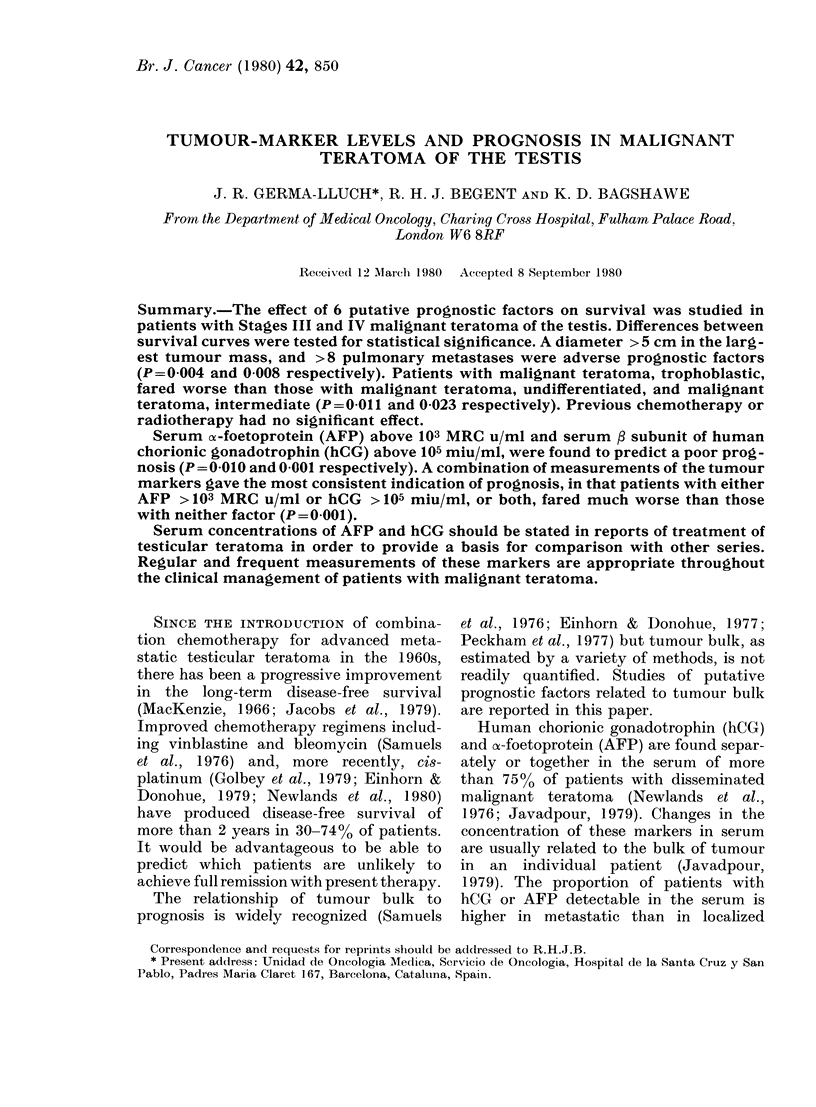
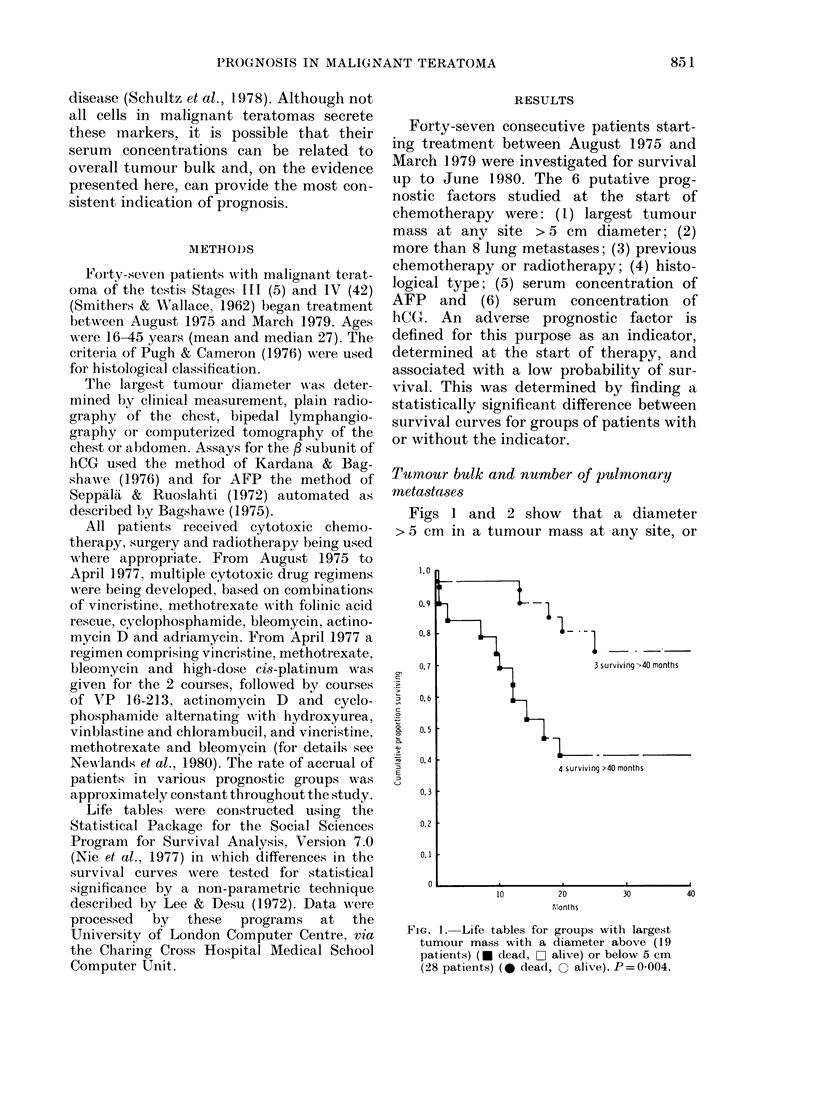

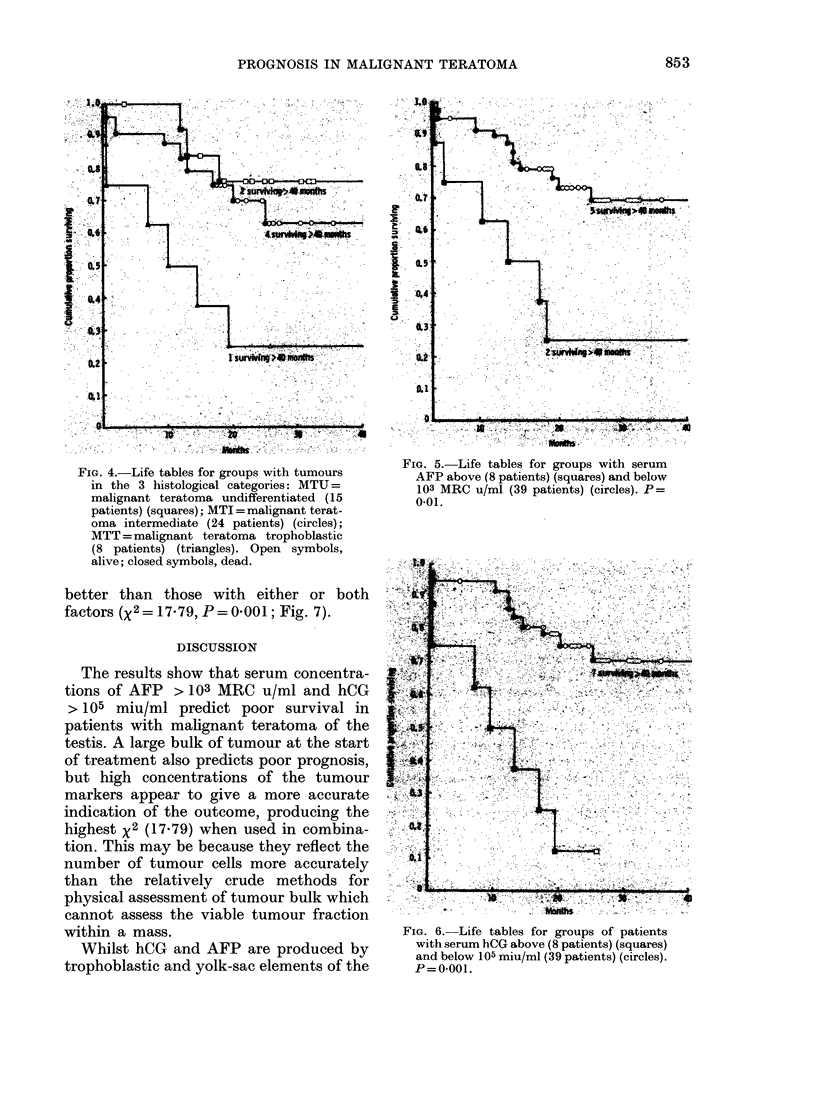
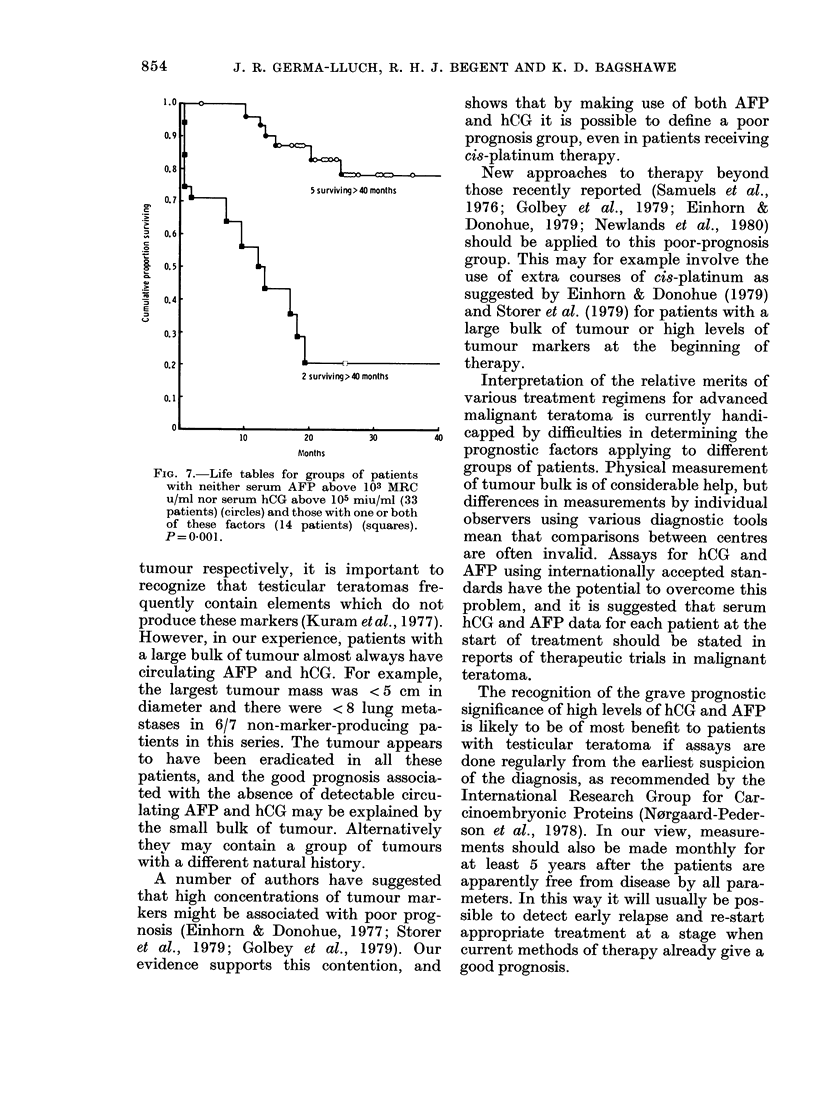
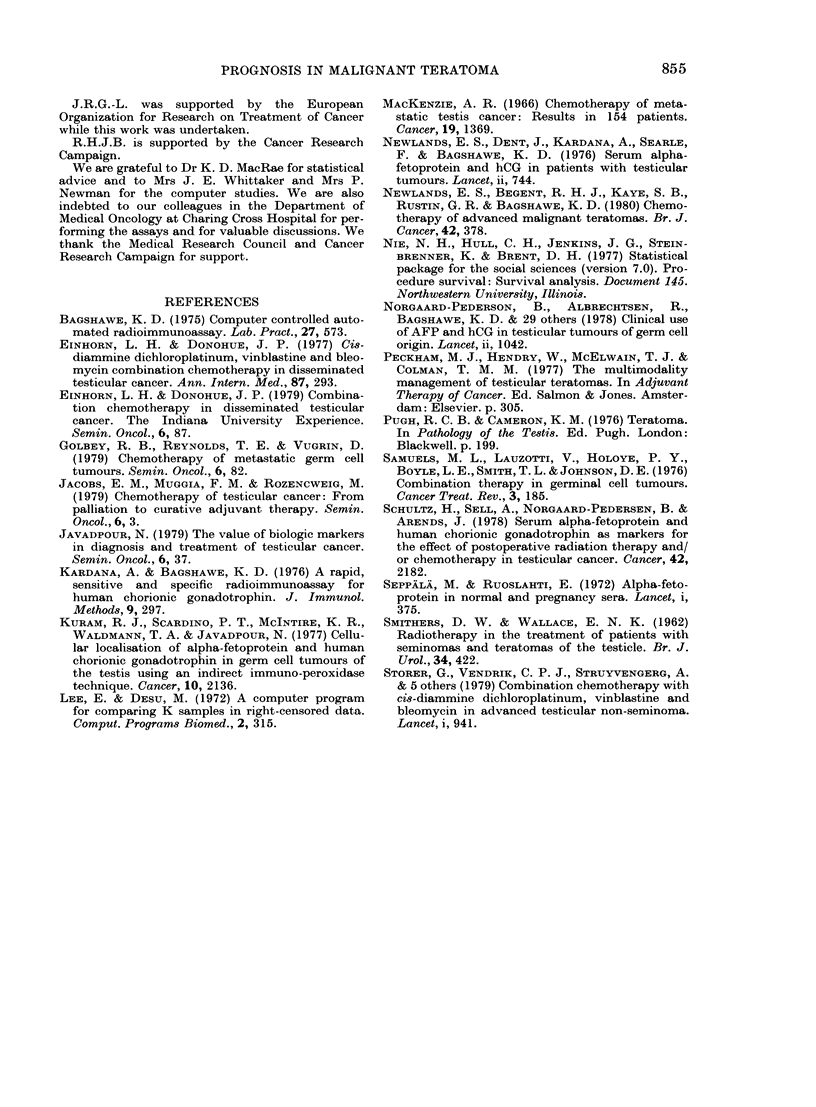
Selected References
These references are in PubMed. This may not be the complete list of references from this article.
- Bagshawe K. D. Computer controlled automated radioimmunoassay. Lab Pract. 1975 Sep;24(9):573–575. [PubMed] [Google Scholar]
- Einhorn L. H., Donohue J. P. Combination chemotherapy in disseminated testicular cancer: the Indiana University experience. Semin Oncol. 1979 Mar;6(1):87–93. [PubMed] [Google Scholar]
- Einhorn L. H., Donohue J. Cis-diamminedichloroplatinum, vinblastine, and bleomycin combination chemotherapy in disseminated testicular cancer. Ann Intern Med. 1977 Sep;87(3):293–298. doi: 10.7326/0003-4819-87-3-293. [DOI] [PubMed] [Google Scholar]
- Golbey R. B., Reynolds T. F., Vugrin D. Chemotherapy of metastatic germ cell tumors. Semin Oncol. 1979 Mar;6(1):82–86. [PubMed] [Google Scholar]
- Jacobs E. M., Muggia F. M., Rozencweig M. Chemotherapy of testicular cancer: from palliation to curative adjuvant therapy. Semin Oncol. 1979 Mar;6(1):3–13. [PubMed] [Google Scholar]
- Javadpour N. The value of biologic markers in diagnosis and treatment of testicular cancer. Semin Oncol. 1979 Mar;6(1):37–47. [PubMed] [Google Scholar]
- Kardana A., Bagshawe K. D. A rapid, sensitive and specific radioimmunoassay for human chorionic gonadotrophin. J Immunol Methods. 1976;9(3-4):297–305. doi: 10.1016/0022-1759(76)90204-0. [DOI] [PubMed] [Google Scholar]
- Kurman R. J., Scardino P. T., McIntire K. R., Waldmann T. A., Javadpour N. Cellular localization of alpha-fetoprotein and human chorionic gonadotropin in germ cell tumors of the testis using and indirect immunoperoxidase technique. Cancer. 1977 Nov;40(5):2136–2151. doi: 10.1002/1097-0142(197711)40:5<2136::aid-cncr2820400524>3.0.co;2-d. [DOI] [PubMed] [Google Scholar]
- Lee E. T., Desu M. M. A computer program for comparing K samples with right-censored data. Comput Programs Biomed. 1972 Nov;2(4):315–321. doi: 10.1016/0010-468x(72)90019-0. [DOI] [PubMed] [Google Scholar]
- Mackenzie A. R. Chemotherapy of metastatic testis cancer. Results in 154 patients. Cancer. 1966 Oct;19(10):1369–1376. doi: 10.1002/1097-0142(196610)19:10<1369::aid-cncr2820191006>3.0.co;2-m. [DOI] [PubMed] [Google Scholar]
- Newlands E. S., Begent R. H., Kaye S. B., Rustin G. J., Bagshawe K. D. Chemotherapy of advanced malignant teratomas. Br J Cancer. 1980 Sep;42(3):378–391. doi: 10.1038/bjc.1980.248. [DOI] [PMC free article] [PubMed] [Google Scholar]
- Newlands E. S., Dent J., Kardana A., Searle F., Bagshawe K. D. Serum alpha1-fetoprotein and H.C.G. in patients with testicular tumours. Lancet. 1976 Oct 2;2(7988):744–745. doi: 10.1016/s0140-6736(76)90044-1. [DOI] [PubMed] [Google Scholar]
- SMITHERS D. W., WALLACE E. N. Radiotherapy in the treatment of patients with seminomas and teratomas of the testicle. Br J Urol. 1962 Dec;34:422–435. doi: 10.1111/j.1464-410x.1962.tb06525.x. [DOI] [PubMed] [Google Scholar]
- Samuels M. L., Lanzotti V. J., Holoye P. Y., Boyle L. E., Smith T. L., Johnson D. E. Combination chemotherapy in germinal cell tumors. Cancer Treat Rev. 1976 Dec;3(4):185–204. doi: 10.1016/s0305-7372(76)80009-6. [DOI] [PubMed] [Google Scholar]
- Schultz H., Sell A., Nørgaard-Pedersen B., Arends J. Serum alpha-fetoprotein and human chorionic gonadotropin as markers for the effect of postoperative radiation therapy and/or chemotherapy in testicular cancer. Cancer. 1978 Nov;42(5):2182–2186. doi: 10.1002/1097-0142(197811)42:5<2182::aid-cncr2820420515>3.0.co;2-7. [DOI] [PubMed] [Google Scholar]
- Seppälä M., Ruoslahti E. Alpha-fetoprotein in normal and pregnancy sera. Lancet. 1972 Feb 12;1(7746):375–376. doi: 10.1016/s0140-6736(72)92865-6. [DOI] [PubMed] [Google Scholar]


